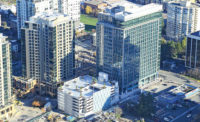...the 190-km highway, is “massively different from Metronet,” says Clarke.
It took some six months longer than planned to close the deal’s financing. “What we had all overlooked was the financial crisis,” says Neil Thomas, group managing director for roads and transportation. The team is now racing to complete $1.6 billion of construction on one of the U.K.’s most congested highways before the July 2012 start of the London Olympic Games.
Design and operational work created by the M25 job is “in the DNA of Atkins,” says Thomas. Around half of Thomas’ roughly 3,000-member staff “are looking after road networks.” The other part of his business, highways consultancy, covers planning, management, intelligent transportation systems and design.
Among Atkins’ other key sectors is railroad engineering, with projects ranging from a Dubai metro to South Africa’s high-speed Gautrain line, the continent’s first. Another sector, the energy business, is “growing strongly,” says Martin Grant, managing director.
Expecting a resurgence in new nuclear construction, Atkins is recruiting about 10 people a month for that business, which now mainly supports operational companies. “There is a pool of around 1,000 people around Atkins with some nuclear expertise,” says Grant.
The firm also runs an internal nuclear academy. “At the very simplest level, we may have an engineer who is specialized in pipe design, [and] we just need to get them talking the language,” says Grant. More involved training can last two months.
Atkins’ renewable focus is building on the firm’s oil and gas expertise gained mainly from structural work in the North Sea, Gulf of Mexico and off West Africa.
“The big opportunity we see is offshore wind...it’s the most advanced,” says Grant. The marine renewable sector is also “a great place for us to be.”

GROUP MANAGING DIRECTOR FOR ROADS, TRANSPORTATION
W.S. ATKINS
In the thermal sector, Atkins is developing expertise in carbon capture, which is attracting increasing U.K. government support. Dealing with carbon emissions is part of Grant’s specific business, but the issue pervades the company, he says.
Geographically, over 70% of the firm’s workload is in the home market. “The U.K. has continued to grow quicker than we thought,” says Clarke.
After cutbacks, the company’s staff of 400 in China has steady work mainly in architecture and urban design. One of its most unusual Chinese jobs is a 400-room hotel being built into the side of a 90-m- deep water-filled quarry...























Post a comment to this article
Report Abusive Comment